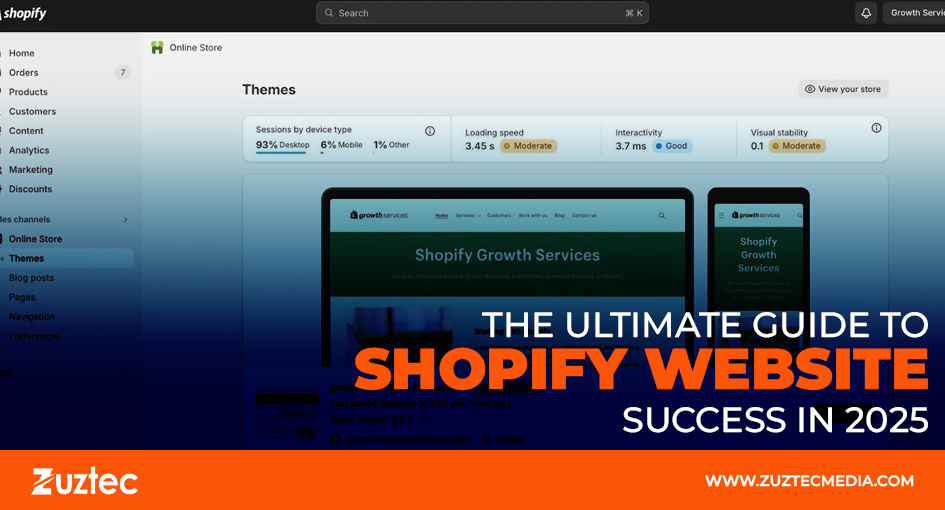
The Ultimate Guide to Shopify Website Success in 2025
In 2025, having a successful Shopify website requires more than just setting up an online store. With increasing competition in the eCommerce space, businesses need to optimize their Shopify stores for performance, user experience, SEO, and marketing to stand out. Shopify remains one of the most popular eCommerce platforms, empowering millions of businesses worldwide with its user-friendly interface, customizable themes, and powerful integrations. However, success on Shopify doesn’t come automatically; it requires a strategic approach to attract visitors, convert them into buyers, and retain them for long-term growth. Consumer expectations are evolving, with mobile-first experiences, fast-loading websites, and seamless checkout processes becoming the norm. Shoppers now demand personalized experiences, easy navigation, and instant customer support. Additionally, with search engines prioritizing user experience, SEO optimization is crucial in driving organic traffic to the Shopify store.
Moreover, leveraging digital marketing strategies such as email marketing, social media advertising, and influencer collaborations can significantly boost the store’s visibility and revenue. A well-optimized Shopify store enhances customer trust, increases conversion rates, and strengthens the brand identity. This ultimate guide will walk the reader through the essential strategies for Shopify store success in 2025, from design and SEO optimization to marketing and customer experience. Whether someone is a new entrepreneur or an established business owner, these insights will help one to maximize the Shopify store’s potential and drive long-term eCommerce success.
Key Elements of a Successful Shopify Website in 2025
Below are the essential elements that contribute to Shopify’s website success in 2025.
1. Choosing the Right Shopify Plan
Selecting the right Shopify plan is crucial for long-term success. Shopify offers different pricing tiers, including Basic, Shopify, and Advanced Shopify, each catering to different business needs.
- Simple Shopify: Perfect for new companies and small enterprises.
- Shopify (Standard Plan): Best for growing businesses with increasing sales.
- Advanced Shopify: Suitable for large-scale businesses needing advanced reporting and lower transaction fees.
Choosing a plan based on your current and projected business needs can help you scale efficiently without unnecessary expenses.
2. Designing a High-Converting Shopify Website
A website that is both aesthetically pleasing and easy to use is crucial for drawing in and keeping clients. Key design principles include the following:
- Use a Professional Theme: Choose a responsive, mobile-optimized Shopify theme that aligns with your brand.
- Improve Site Navigation: Ensure an intuitive layout with easy access to product categories, search bars, and filters.
- Optimize for Mobile: Over 70% of online shoppers use mobile devices, so your Shopify store must be fully responsive.
- Use High-Quality Images: Crisp, clear product images enhance credibility and increase conversions.
A well-designed Shopify store not only attracts visitors but also encourages them to make a purchase.
3. Optimizing for SEO and Organic Traffic
Search engine optimization (SEO) is critical for driving organic traffic to your Shopify website. Implement the following SEO strategies:
- Optimize Product Titles and Descriptions: Use relevant keywords naturally to improve search rankings.
- Improve Page Load Speed: Compress images, enable caching, and use a fast-loading Shopify theme.
- Create SEO-Friendly URLs: Keep URLs short, descriptive, and keyword-rich.
- Use Alt Text for Images: Help search engines understand your images and improve accessibility.
- Start a Blog: Regularly publishing informative blog content can help attract more visitors.
A strong SEO strategy ensures long-term visibility and organic traffic growth.
4. Leveraging Marketing Strategies for Growth
A well-planned marketing strategy is key to driving traffic and increasing sales. Some effective marketing tactics include:
- Email Marketing: Send personalized offers, product recommendations, and abandoned cart emails to boost conversions.
- Social Media Advertising: Run Facebook, Instagram, and TikTok ads to reach your target audience.
- Influencer Collaborations: Partner with influencers in your niche to promote your Shopify store.
- Google Shopping Ads: Use Google Ads to display your products at the top of search results.
- Retargeting Campaigns: Target visitors who didn’t complete a purchase with remarketing ads.
Combining these strategies can significantly improve your Shopify store’s success.
5. Enhancing Customer Experience for Higher Conversions
Customer experience is a major factor in determining Shopify store success. Focus on the following areas:
- Fast Checkout Process: Reduce cart abandonment by offering guest checkout and multiple payment options.
- Live Chat and Support: Provide instant customer support through chatbots or live agents.
- Personalization: Use AI-powered recommendations to suggest products based on browsing behavior.
- Customer Reviews and Testimonials: Showcase social proof to build trust and credibility.
A seamless shopping experience increases customer satisfaction and encourages repeat purchases.
6. Using Shopify Apps to Boost Performance
Shopify’s App Store offers various tools to enhance functionality and improve store performance. Some must-have apps include:
- SEO Booster: Helps optimize your site for better search rankings.
- Klaviyo or Omnisend: Advanced email marketing automation tools.
- Oberlo (for Dropshipping): Simplifies product sourcing and order fulfillment.
- Tidio Live Chat: Enables real-time customer support.
- ReConvert Upsell & Cross Sell: Boosts average order value through upselling.
Choosing the right apps can help automate tasks, optimize sales, and improve overall efficiency.
Key Factors for Shopify Website Success in 2025
To achieve Shopify store success in 2025, businesses must focus on design, SEO, marketing, and customer experience. Implementing the right strategies will help attract more visitors, improve conversions, and build a loyal customer base.
To conclude, a successful Shopify website in 2025 requires more than just an appealing design, it demands strategic planning, optimization, and continuous improvement. By choosing the right Shopify plan, optimizing for SEO, leveraging marketing strategies, enhancing user experience, and utilizing powerful apps, businesses can create a high-performing store that stands out in the competitive eCommerce space. Whether you’re launching a new Shopify store or refining an existing one, following these best practices will ensure long-term growth and success. Start optimizing your Shopify store today and take your eCommerce business to new heights!

